NORTH WALES COAST RAILWAY:NOTICE BOARD
Rheilffordd arfordir gogledd Cymru: Hysbysfwrdd
22 March 2021





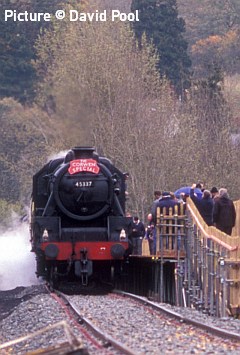
Forthcoming events
(see also our Calendar page for venues)
Note: we have removed all entries relating to meetings as the events are cancelled.
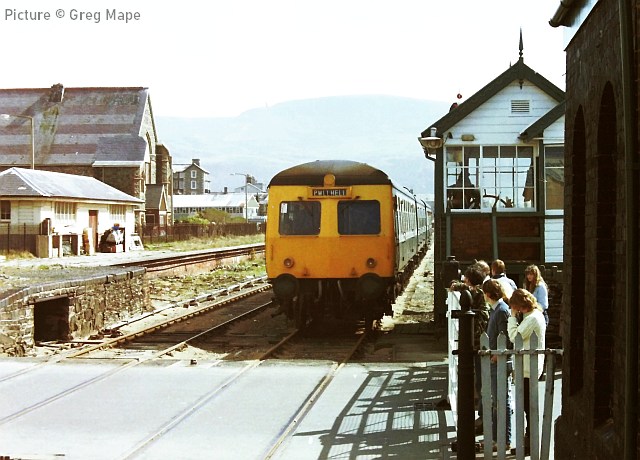
Class 120 'Cross Country' DMU for Pwllheli arrives at Barmouth, 1980s. Picture by Greg Mape.
News pictures
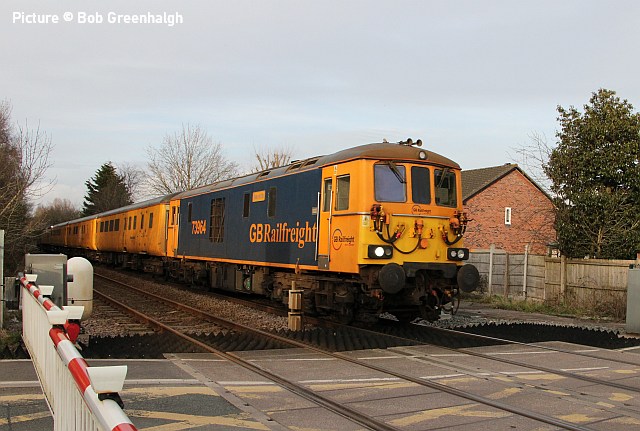
Monday 16 March saw 73 964 heads over Green Lane crossing, Saltney with 73 962 on the tail as they head for Bidston. The Network Rail train ran 60mins early, great as they were in daylight!
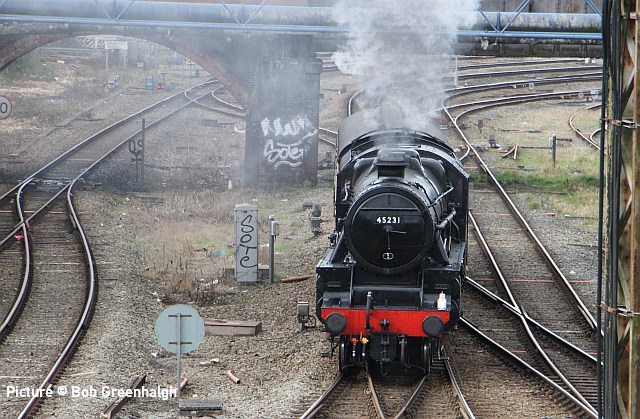
Then on 17 March we had a real treat, steam on a test run from Crewe to Chester and back. I've missed the sight and smell of steam. Above, 45231 departs Chester for Crewe. (Here's a Youtube video by Phil Clarke.)
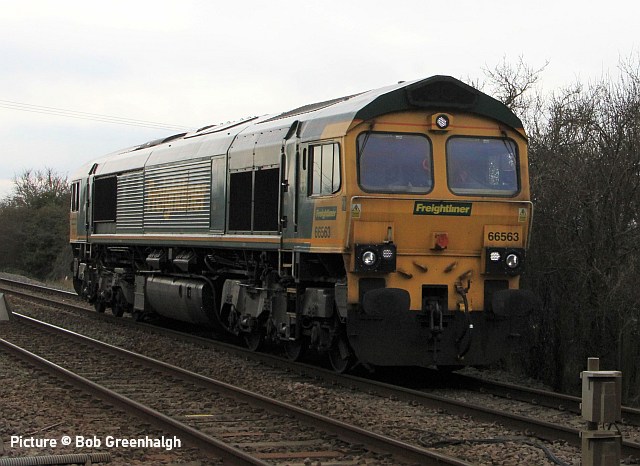
Then to top off the day. 66 563 on a route learner is about to pass Green Lane crossing, Saltney, as it heads to Chester. (Pictures by Bob Greenhalgh)
Drainage work on the Mid-Cheshire line
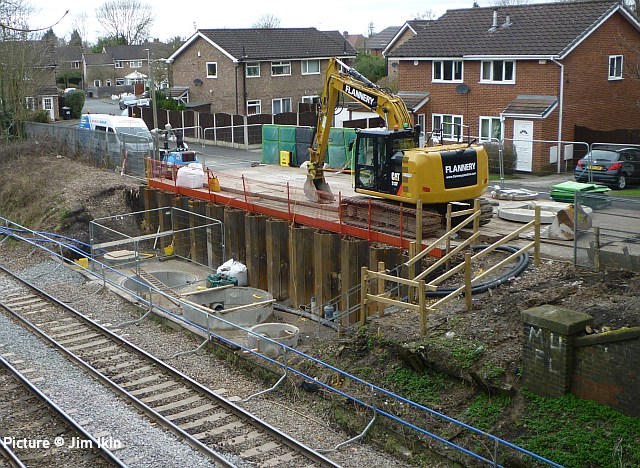
Flooding on the track has occurred for some time in areas close to the old Baguley station site between Stockport and Altrincham, and contractors have moved in to remedy the problem. A pumping station is being located around 500 yards from the location of the old station (above) adjacent to the Stockport Road bridge (Jim Ikin).
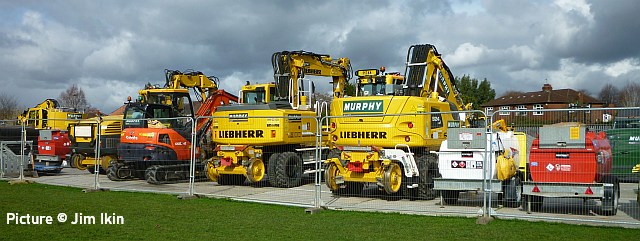
Base camp for the contractors has been established adjacent to Stoney Bridge near Skelton Junction (Jim Ikin).
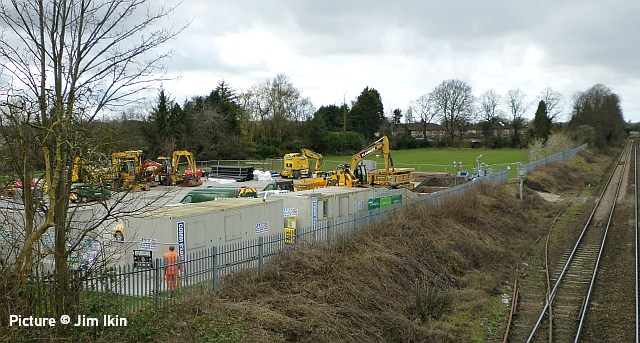
Access for road/rail vehicles has been made by removing part of the embankment and crossing over the redundant Skelton loop (Jim Ikin).
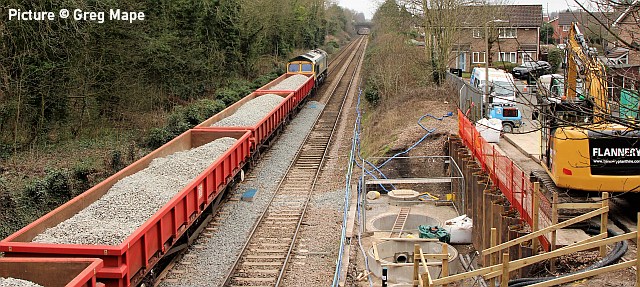
The track is also being re-laid: here's a Sunday scene with work in progress and am engineering train. The stone is not being used for track relaying, but as a source of stone and for dumping soil and stone dug out for the drainage work; there is a trench being dug by the side of the sleepers, it looks like the track is being renewed but track but is the original, with the
ballast dug out.(Greg Mape).
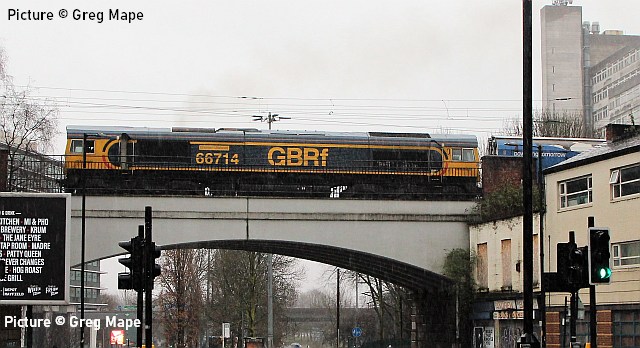
A Sunday diversion due to the above work approaches Mancheter Piccadilly. In the last update we claimed that a train from the Deansgate direction was empty: in fact that one, and this, are heading to Drax with another load of wood pellets imported from the USA. (Greg Mape).
From Dave Sallery's archive
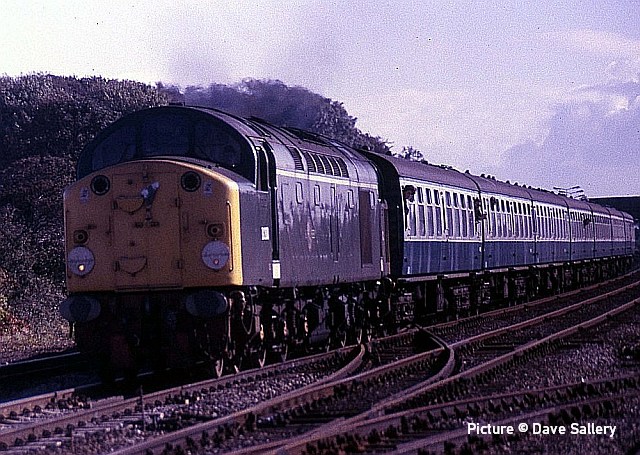
40 122 in 'heritage' green passes Prestatyn on the 08:20 Stoke to Llandudno service, 11 September 1986.
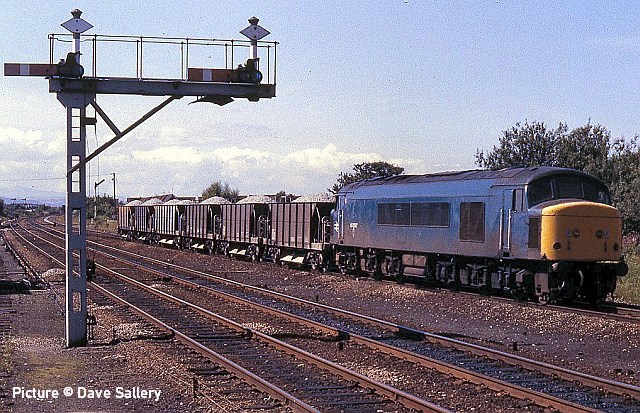
45 058, Prestatyn, 20 August1986. Ballast from Penmaenmawr.
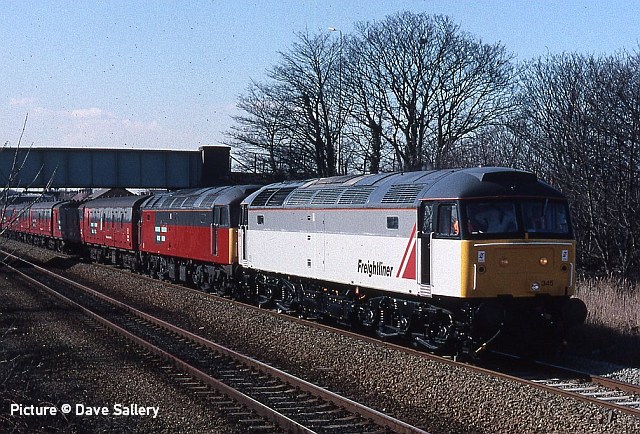
The first Freightliner-liveried 47, 47 345, on test from Crewe Works. passing Prestatyn, with 47 596 for 'insurance'. 7 March 1996.
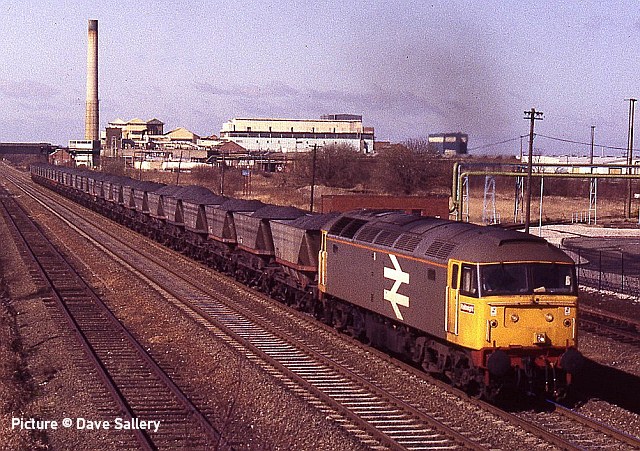
Holywell Junction, 18 March 1987. 47 350 on a coal train from Point of Ayr passing the now-demolished Courtaulds Greenfield plant.
Class 37 era mystery - by Tony Flusk.
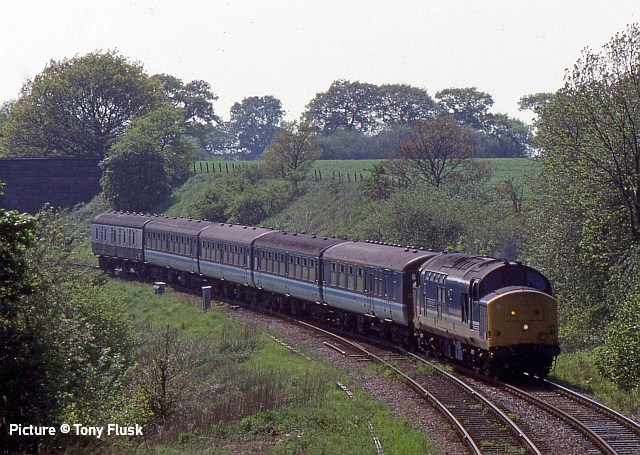
Noting the photograph of 37 420 The Scottish Hosteller on the Mid-Cheshire line near Delamere, on the notice board, reminded me that for only a few weeks (possibly months) around this time a extra diagram operated, presumably due to dire availability of units.
From what I can recall, it was a morning commuter service into Manchester,from Chester or maybe further down the coast, which then returned empty stock to Chester Middle Yard via Northwich. Mid afternoon it would again head to Manchester ECS via Northwich to work an evening Manchester - Chester (or again even further).
Above is an image of 37 425 Concrete Bob approaching Mouldsworth with the afternoon ECS. A trawl of the web doesn't show anything for these trains, making me think it was a very short term stop gap measure. Can anyone confirm?
Looking back : Llangollen 2014 - with David Pool
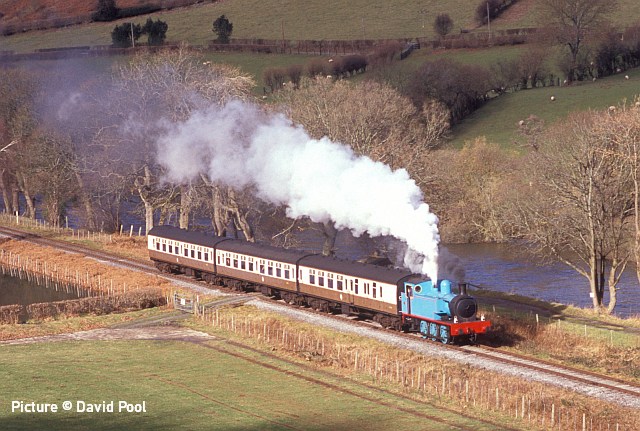
At first sight this seems to be the usual Thomas approaching Glyndyfrdwy on 16 February 2014, but this is Jessie, a Hunslet built in 1937 for the East Moors Steelworks in Cardiff. The Jinty 47298 Thomas was under repair, so Jessie was converted from a Saddle Tank to a Side Tank and repainted to become Thomas. The owner of Jessie, Mike Pearce, recounts the restoration story at the Barry Tourist Railway in 2016 on a YouTube video Since then Jessie has been converted back to a Saddle Tank at Barry.
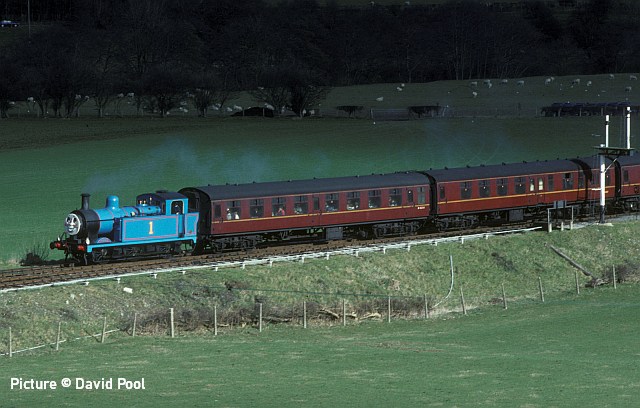
For comparison, Llangollen’s 'Jinty' Thomas was approaching Carrog on 21 February 1998, and entering a patch of sunlight. The side tanks and rear bunker shape are not as true to the original as those on Jessie, but the number 1 and the face on the smokebox are just what the children were wanting!
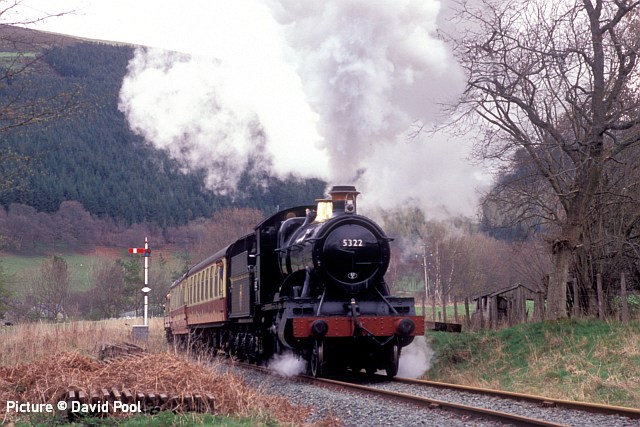
GWR Mogul 5322 has just left Carrog on 4 April 2014. It was built in 1917, then sent to France as Railway Operating Division locomotive No. 5322. After its return to the UK in 1919 it moved between many locations, ending at Pontypool Road, from where it was withdrawn in 1964 and taken to Woodham’s at Barry. Restored originally at Caerphilly and then at Didcot, 5322 paid a short visit to Llangollen in 2014, but on its return to Didcot various boiler problems have meant that it is now a static exhibit.
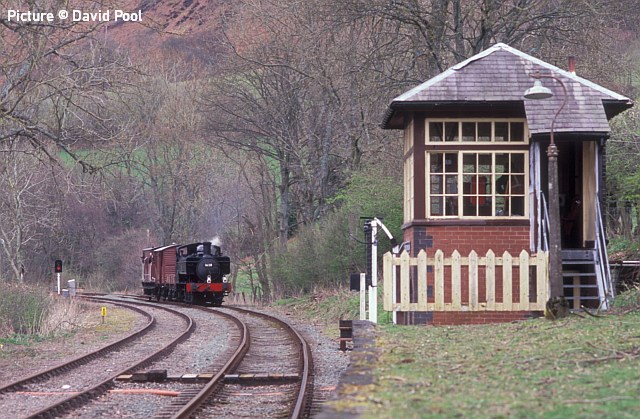
It is always satisfying to have a change from the usual photo locations on the Llangollen Railway, and Deeside Loop provided a nice shot of the 16XX Class 1638 on a short goods train on 4 April 2014. Built in 1951, it was based at Llanelli, Oswestry and finally Croes Newydd. It was sold in 1967 and moved under its own steam to Buckfastleigh for use on the Dart Valley Railway.
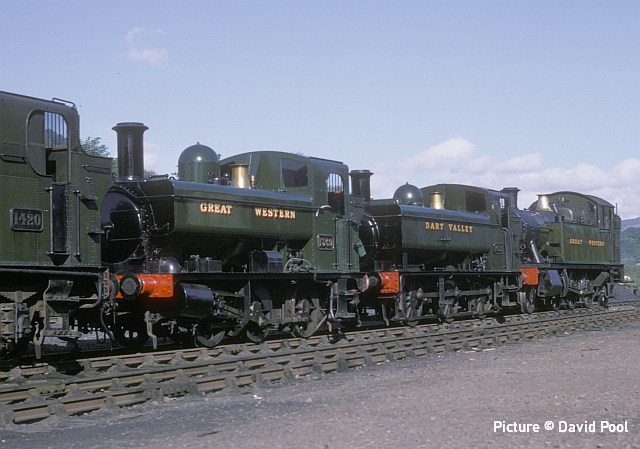
At Buckfastleigh on 29 September 1969, 1638 was with 1420, 1369 and 4555, the line having reopened for passengers earlier that year. In 1971 the Dart Valley Railway was given the opportunity to purchase the line form Paignton to Kingswear, but by 1989 the Buckfastleigh line was declared to be uneconomic. The Dart Valley line and locomotives were taken over in 1991 by the South Devon Railway, who then sold 1638 in the following year to the Kent and East Sussex Railway, where it is now based.
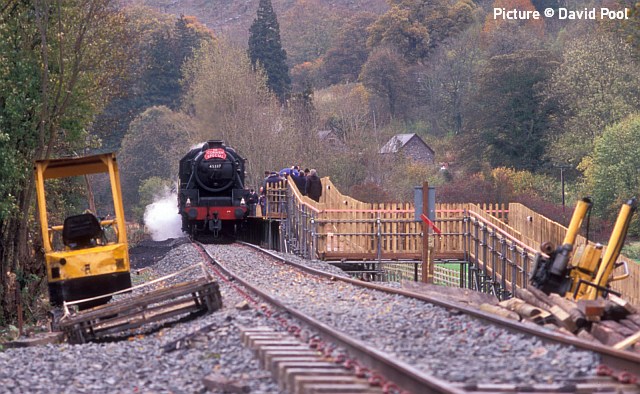
The new station at Corwen East was opened on 22 October 2014. After assisting the first train headed by 3802, Black 5 45337 headed the afternoon train, and has reached the end of the line/ The temporary nature of the platform is evident from this viewpoint. If this view looks familiar, a similar photo by Ken Robinson appeared in the NWCR News for 27 October 2014 – perhaps not surprising with so many photographers around.
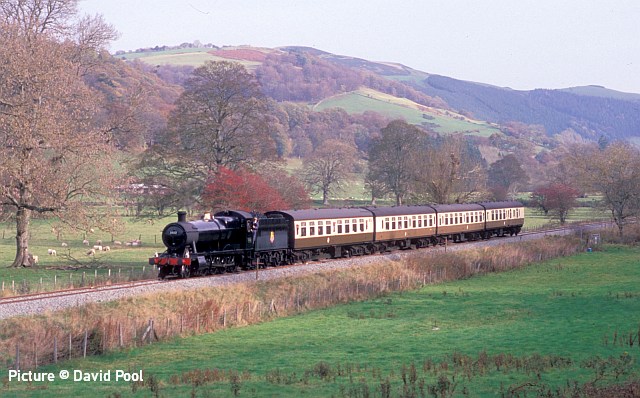
On 31 October the arrangements for working to Corwen East had changed, and the need for two locomotives in top and tail mode was avoided by propelling the trains back from Corwen to Carrog. 3802 is heading for Corwen and near Bridge 28A on the new line, viewed from the A5 after I had walked from Corwen. Parking on the A5 is not an option!
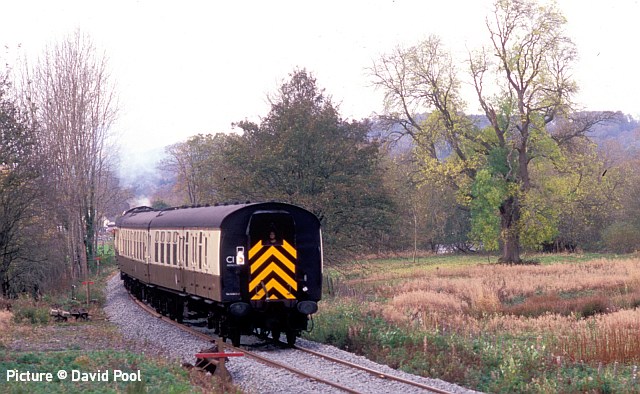
The propelling movement required the rear coach to be converted to a Propelling Control Vehicle, and although not particularly photogenic, it was an interesting record shot as the train returned to Carrog.. George Jones has given details of the PCV in the same NWCR News for 27 October 2014 .
Shotton 2002 - images by Tim Rogers
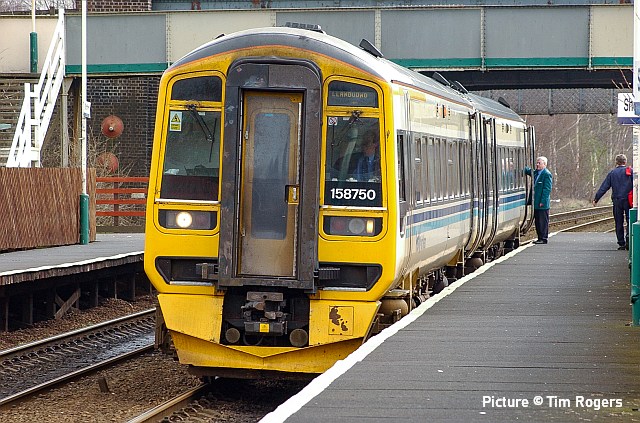
A selection from 22 March 2002 at Shotton first the Low Level station. First North Western unit 158 750 was still in Regional Railways 'express' livery, seen working 09:17 Manchester Piccadilly to Llandudno. First North Western received just eight 158s, 752-759; when the 158s were being built for British Rail, more were intended, but instead a batch was delivered to Network South East for the London - Exeter service: a decision which led to the instruction of Class 37 locos to North Wales, leading in turn to this website.
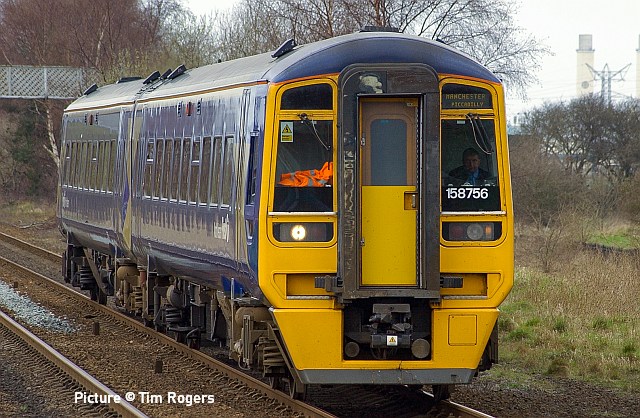
By contrast, 158 756. seen on the 09:46 Llandudno to Manchester Piccadilly, has 'First' branding overlaid on the livery used by First North Western for units inherited from British Rail. The 'blue with gold stars' scheme was actually devised by FNW's short-lived predecessor, North Western Trains. North Wales was a regular haunt of the fleet, but they also appeared on the services from Blackpool and Rochdale to London which had been promised as part of the franchise; sadly, Virgin insisted that they could not call at Virgin-served stations, and with the 158's maximum speed of 90 mph, the low fares were not enough to impress passengers.
Today's 'Northern' has many more 158s, some inherited when the companies west and east of the Pennines were combined into Northern, and recently 'hand-me-downs' from better-funded franchises . 752 to 759 are still in the fleet, but the only 158s seen at Shotton are Transport for Wales units in 818-841 series, due for repacement soon (?) with new stock.
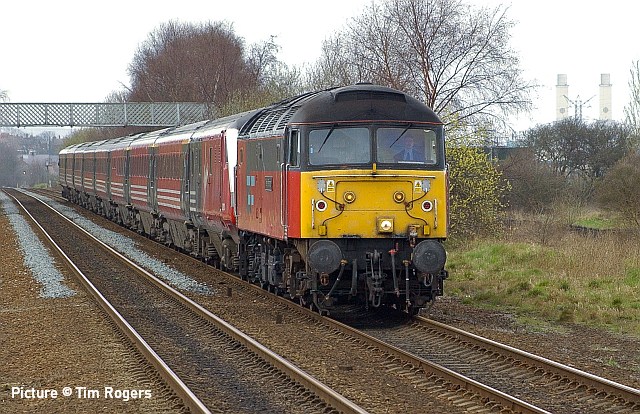
In 2002 the 'Pendolinos' had yet to appear, and Class 47 haulage was still the order of the day on Holyhead - London services. Virgin had its own fleet of 47s, but their reliability was declining, and 47 774 Poste Restante, hired from EWS was hauling 1A46 09:19 Holyhead to Euston as far as Crewe, where it would be detached and an electric loco connected to the rear; the driver would operate from the Driving Van Trailer seen behind the loco.
47 774 only lasted a few more weeks in traffic before being 'stored unservicable' and later dismantled. It's complex career is best examined by visiting the marvellous Class47.co.uk website.
DVTs appeared again in recent years, with the ex-Virgin Mk3 coaches used for some Holyhead - Cardiff and North Wales - Manchester runs., but the promised revival of loco-hauled Cardiff express will feature ex-East Coast Mk4 carriages and DVTs.
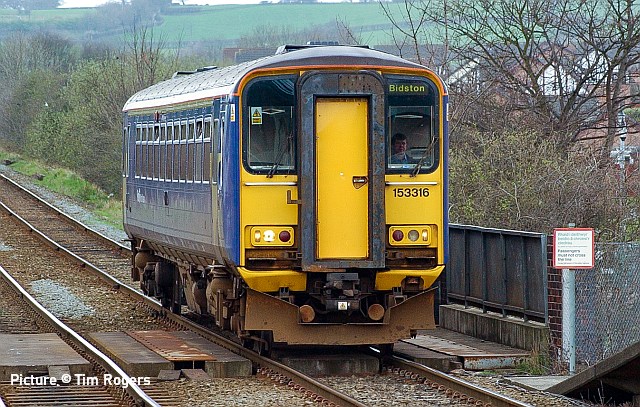
Up on the high-level 'Borderlands' line class 153s were providing the service. 153 316 (sagging a little in the centre) was seen at Shotton with the 10:32 Wrexham to Bidston. Regional Railways had created these single 'Tin Rocket' or 'dog-box' railcars by spitting two-car 155s and adding two new cabs and one new toilet.
Arriva Trains Wales replaced them on this line with 2-car 159s; recently Transport for Wales have been gathering in a larger fleet of 153s from other areas, and tried to bring 153s back as a temporary measure until the new Class 230 London Underground rebuilds could start, but they were 'fended off' by passenger user groups, and for the moment, 150s remain.
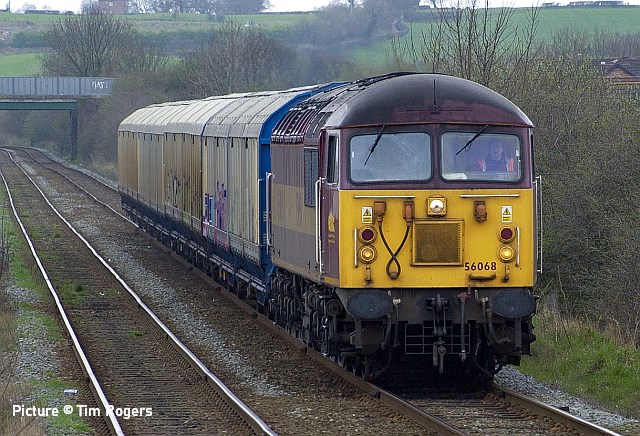
And a freight train: 56 068 passes with the 6F59 09:15 Warrington Arpley Marshalling Yard to Dee Marsh 'Enterprise' service. 'Enterprise' was brand devised by EWS to continue the traditional 'wagon-load' trains which would serve several customers and terminals. This particular 'trip working' served only the nearby Shoton Paper newsprint works.
In 2002 a grand plan was unveiled to create a new connection between the two lines at Shotton: a BBC News report explains. Needless to say, nothing happened. The rail service no longer runs, and the paper company are hoping to see the plant.
News from TfW, etc.
'Transport for Wales has been awarded £100,000 from the Welsh Government’s Local Places for Nature scheme and the National Lottery Heritage Fund to enhance local biodiversity at and near its railway stations. TfW will introduce green features for up to 22 of its stations in areas where major enhancement works are taking place on its network – including green walls, green roofs, planters, hanging baskets, trees and water butts.'
'Beehives, bird houses, bat boxes, bug hotels, hedgehog houses and ladybird houses will also be introduced to boost local biodiversity. As part of the project TfW will support local biodiversity projects in collaboration with five community partners within one mile of its railway stations.'
(Full press release here)
Good luck to them we say - although volunteer groups aroud the UK have being doing this kind of thing for years. Northern in particular has made a point of funding materials and plants for such work, as have Transport for Greater Manchester.
On a much larger scale, we read that 'A 25-million pound scheme to transform the main route into Wrexham has received a big boost after funding was allocated to transform the town’s main railway station. The Wrexham Gateway project will result in the redevelopment of the site around the station, including commercial developments and upgrades to public spaces ... The overall scheme aims to regenerate the Mold Road corridor by creating better-connected bus and rail transport, as well as improvements to Wrexham AFC’s Racecourse Ground by creating a new stand at the Kop end.'
From Greg Mape's slide box
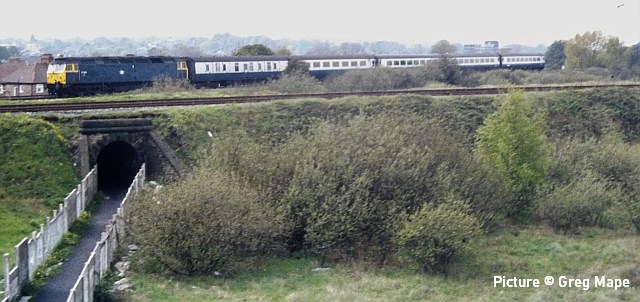
In 1985 (so I am informed) with Birmingham New Street to Manchester Piccadilly service diverted via the Warrington - Skelton Junction line. The line closed not long after this and is now part of the Trans Pennine Trail.
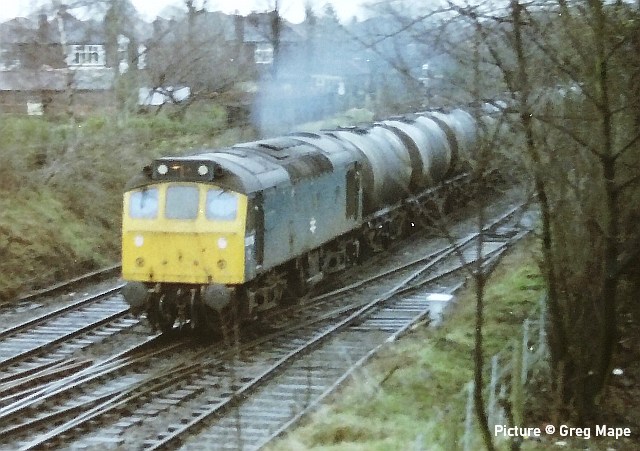
Class 25 on cement tanks, Skelton Junction.
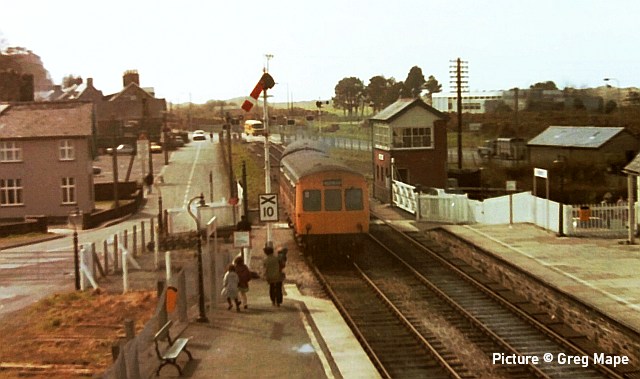
Class 101 at Harlech ...
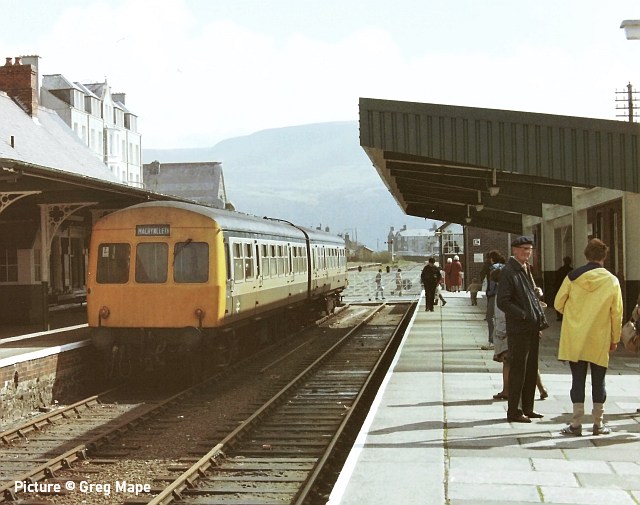
... and Barmouth, 1980s.
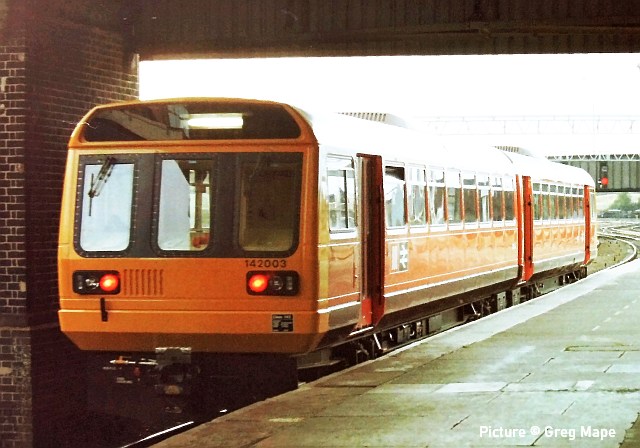
New-looking 142 003 at Chester, in Greater Manchester livery.
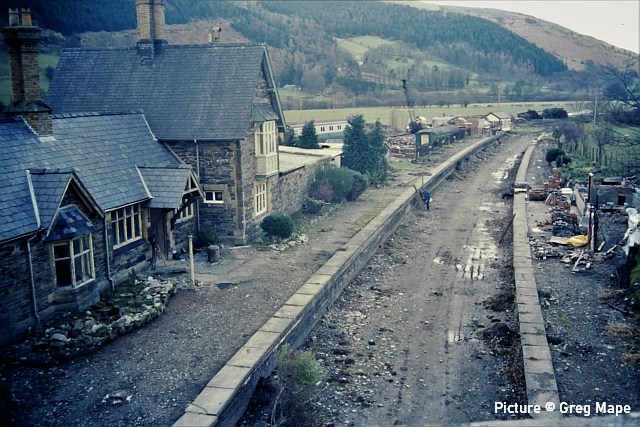
Carrog station before Llangollen Railway metals reached it, a target reached in 1996. If you want to help keep the line running in the future, donations are welcome.
North Wales Coast home page | Archive | Previous Notice Board